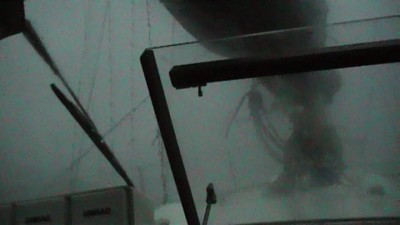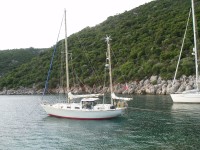
Singlehanded aboard Salara
02 December 2021 | Spain
12 November 2021 | Spain
31 October 2021 | Spain
29 September 2021 | Spain
08 July 2021 | Portugal
08 November 2020 | Portugal
31 July 2020 | Portugal
05 April 2020 | Portugal
16 November 2019 | Portugal
14 October 2019 | Spain
07 October 2019 | Spain
13 September 2019 | Spain
03 September 2019 | Spain
17 July 2019 | Spain
21 June 2019 | Spain
17 May 2019 | Spain
08 November 2018 | Portugal
26 October 2018 | Spain
26 September 2018 | Spain
23 August 2018 | Balearic Islands, Spain.
Salara drags her anchor
13 November 2012 | Greece
Peter

It was at the end of September that ‘Salara’ had arrived back in the Ionion and with a month to go before she was due to be hauled out for her winter
lay up I spent the time visiting some of my favourite anchorages among the islands. I had no fixed schedule and just sailed and anchored where the breeze and my fancy took me.
As the weather cooled down so the amount of tourists diminished and other yacht owners were putting their boats ashore. The end of another season’s sailing was in sight and I had started to plan the work that I had to do on ‘Salara’ once she was ashore. The jobs list that I try so hard to minimise during the summer was once more growing in length. I was also beginning to purchase materials to use on these tasks once the time came.
A feature of this time of year in The Ionion are the frequent thunderstorms that occur, they are mostly short lived and cause little trouble but there are exceptions, one of which is worth relating.
In the middle of October I was sailing ‘Salara’ from Nisos Kalamos to Nidri on Nisos Levkas it was a lovely afternoon and I was having a pleasant sail but I could see clouds developing over the mountains of Levkas and hear the faint rumble of thunder in the distance. ‘Nothing really to worry about’ I thought as I prepared to anchor ’Salara’ in Vlikho Bay that evening. However, I did take extra care to make sure the anchor was well dug in and I veered 50 metres of chain in the 7 metres of depth. I also put extra ties around the sail covers as a precaution because I knew that this anchorage was prone to gusts from the mountains in these conditions. I then settled down for the night feeling very self righteous.
The following morning at 0800hrs I made my routine entry in the Ships Logbook stating that wind conditions were ‘still’ but I continued to hear thunder in the mountains. At 0830hrs I was just about to prepare my breakfast while muttering darkly about a thunderstorm that had just started when suddenly I heard wind noise and went into the cockpit just in time to see ‘Salara’ engulfed by a solid wall of wind and rain and the visibility was reduced to nothing. ‘Salara’ heeled over until her side deck was almost in the water and as she fell back I waited for the anchor to pull her head around into the tempest but this did not happen and I realised that the anchor was dragging. Luckily I had the engine running to charge the batteries so I was able to power her head to wind to relieve the strain on the anchor but it continued to drag which I could tell by watching the GPS otherwise I could see very little. I knew that there was room downwind as we were dragging parallel to the shore but there were some other yachts at anchor or on moorings. ‘Salara’ came very close to one or two but I saw them at the last moment and managed to steer her clear. After the initial blast the visibility was slowly improving and I was aware that the inflatable dinghy was airborne and doing an impression of a headless chicken with its captive oars flapping like wings. My main concern was of fouling another yacht’s anchor as in those conditions that would have been a nightmare.
The squall only lasted about ten minutes but in that time ‘Salara’ had dragged over 300 metres and when the wind had eased and the visibility had improved I was able to retrieve the anchor which had a huge ball of mud on its fluke, it had obviously been ripped out of the seabed at the first gust. I then motored over to the other side of the bay and dropped anchor again this time veering the maximum amount of chain available. I checked around on deck and no damage had been done and I still had a dinghy. Other yachts in the anchorage were not so lucky as I could see many a tattered genoa and ripped canvas cover. Later I learnt that wind speeds had been between 50 and 60 knots although I had only seen speeds in the upper 40’s on ’Salara’s’ instruments, it was certainly strong enough for me. A short time later I was eating a late breakfast and the sun was shining.
In the midst of this mayhem I had managed to grab the camcorder and take some video, a frame of which you see above.
The rest of October passed without any undue excitement and I enjoyed some easy and relaxing sailing until it was time to head north through the Levkas Canal to Preveza and onward to Vonitsa in the Gulf of Amvrikakis.
In Vonitsa I removed the sails and packed them away as well as doing as much as possible in the way of maintenance. All that remained was to motor ‘Salara’ the short distance to Cleopatra Marina on the appropriate date for haul out and winter storage ashore.
lay up I spent the time visiting some of my favourite anchorages among the islands. I had no fixed schedule and just sailed and anchored where the breeze and my fancy took me.
As the weather cooled down so the amount of tourists diminished and other yacht owners were putting their boats ashore. The end of another season’s sailing was in sight and I had started to plan the work that I had to do on ‘Salara’ once she was ashore. The jobs list that I try so hard to minimise during the summer was once more growing in length. I was also beginning to purchase materials to use on these tasks once the time came.
A feature of this time of year in The Ionion are the frequent thunderstorms that occur, they are mostly short lived and cause little trouble but there are exceptions, one of which is worth relating.
In the middle of October I was sailing ‘Salara’ from Nisos Kalamos to Nidri on Nisos Levkas it was a lovely afternoon and I was having a pleasant sail but I could see clouds developing over the mountains of Levkas and hear the faint rumble of thunder in the distance. ‘Nothing really to worry about’ I thought as I prepared to anchor ’Salara’ in Vlikho Bay that evening. However, I did take extra care to make sure the anchor was well dug in and I veered 50 metres of chain in the 7 metres of depth. I also put extra ties around the sail covers as a precaution because I knew that this anchorage was prone to gusts from the mountains in these conditions. I then settled down for the night feeling very self righteous.
The following morning at 0800hrs I made my routine entry in the Ships Logbook stating that wind conditions were ‘still’ but I continued to hear thunder in the mountains. At 0830hrs I was just about to prepare my breakfast while muttering darkly about a thunderstorm that had just started when suddenly I heard wind noise and went into the cockpit just in time to see ‘Salara’ engulfed by a solid wall of wind and rain and the visibility was reduced to nothing. ‘Salara’ heeled over until her side deck was almost in the water and as she fell back I waited for the anchor to pull her head around into the tempest but this did not happen and I realised that the anchor was dragging. Luckily I had the engine running to charge the batteries so I was able to power her head to wind to relieve the strain on the anchor but it continued to drag which I could tell by watching the GPS otherwise I could see very little. I knew that there was room downwind as we were dragging parallel to the shore but there were some other yachts at anchor or on moorings. ‘Salara’ came very close to one or two but I saw them at the last moment and managed to steer her clear. After the initial blast the visibility was slowly improving and I was aware that the inflatable dinghy was airborne and doing an impression of a headless chicken with its captive oars flapping like wings. My main concern was of fouling another yacht’s anchor as in those conditions that would have been a nightmare.
The squall only lasted about ten minutes but in that time ‘Salara’ had dragged over 300 metres and when the wind had eased and the visibility had improved I was able to retrieve the anchor which had a huge ball of mud on its fluke, it had obviously been ripped out of the seabed at the first gust. I then motored over to the other side of the bay and dropped anchor again this time veering the maximum amount of chain available. I checked around on deck and no damage had been done and I still had a dinghy. Other yachts in the anchorage were not so lucky as I could see many a tattered genoa and ripped canvas cover. Later I learnt that wind speeds had been between 50 and 60 knots although I had only seen speeds in the upper 40’s on ’Salara’s’ instruments, it was certainly strong enough for me. A short time later I was eating a late breakfast and the sun was shining.
In the midst of this mayhem I had managed to grab the camcorder and take some video, a frame of which you see above.
The rest of October passed without any undue excitement and I enjoyed some easy and relaxing sailing until it was time to head north through the Levkas Canal to Preveza and onward to Vonitsa in the Gulf of Amvrikakis.
In Vonitsa I removed the sails and packed them away as well as doing as much as possible in the way of maintenance. All that remained was to motor ‘Salara’ the short distance to Cleopatra Marina on the appropriate date for haul out and winter storage ashore.
Comments
| Vessel Name: | Salara |
| Vessel Make/Model: | Nicholson 38 Ketch |
| Hailing Port: | Lymington UK |
| Crew: | Peter Needham (owner/skipper) |
| About: | 2007/8 Atlantic circuit. 2009/13 Cruising in the Mediterranean. 2014 Atlantic coasts of Spain and Portugal. |
| Extra: | The indispensable Hydrovane self steering. Eats nothing, uses no power and never complains. |
Gallery not available
Salara

Who: Peter Needham (owner/skipper)
Port: Lymington UK